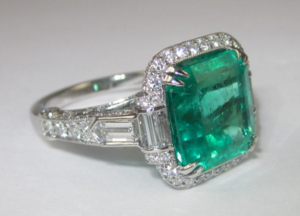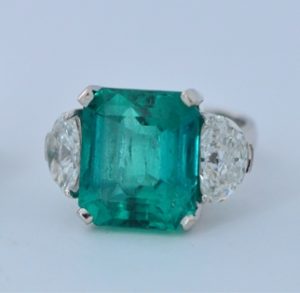 If you want to sell an emerald ring in Los Angeles, the first question on your mind is likely, “How much is my emerald worth?” There are various factors which impact the value of an emerald, and we will cover each one in this article on appraising the value of an emerald gemstone.
If you want to sell an emerald ring in Los Angeles, the first question on your mind is likely, “How much is my emerald worth?” There are various factors which impact the value of an emerald, and we will cover each one in this article on appraising the value of an emerald gemstone.
Emeralds are the most precious gemstones from the beryl group of minerals, and are widely known and valued for their exquisite green coloring. Ranging from greenish blue to bluish green, emeralds have been used in nearly all kinds of jewelry since 2000 BCE, and they display a depth of color that few colored gems can match.
Emeralds, like many precious stones, are judged by the classic “Four Cs:” color, clarity, cut, and carat weight. And like most colored gemstones, color is the most important quality when evaluating an emerald. But because emeralds are almost as famous for their inclusions as they are for their color, clarity is nearly as important as color when determining the ultimate value of a stone.
Learn How Emerald Gem Color Affects Value
No gemstone says green like an emerald, and in fact it is the color alone that distinguishes an emerald from the lesser varieties of beryl. The most sought after emeralds are bluish green to pure green, highly transparent, with evenly distributed color. Any emerald that is too yellow or too bluish is simply considered beryl, and its value is accordingly low.
Evaluating color in gems is generally done by considering hue, tone, and saturation. Hue in emeralds simply refers to the type of green, whether nearly pure, slightly yellowish, or slightly bluish. Many emeralds on the market today are mined in Colombia, and these are generally thought to be a warm and nearly pure green, while emeralds from Zambia are typically more bluish. Although mine location is a potential indicator of color in emeralds, any particular mine may yield stones with a variety of hues.
Tone refers to the relative lightness and darkness of the stone, and emeralds can be classified anything from “very light” to “very dark.” While medium and dark toned emeralds may ultimately be more valuable, it is the saturation that gives an emerald’s color intensity and strength. Saturations can run from “dull” to “pure vivid,” with vivid stones commanding the highest prices. While a light emerald with vivid saturation might in fact be more valuable than a darker tone with less saturated color, darker tones and higher saturations are generally the most expensive.
Learn How Emerald Gem Clarity Affects Value
 Emeralds are one of the most included of all gemstones. The Gemological Institute of America classifies emeralds as a “type III” gemstone, indicating that they are nearly always included with at least slight imperfections of one kind or another. Eye clean emeralds, with no inclusions visible to the naked eye, are extremely rare and valuable. So prevalent are inclusions that they are known in emeralds as “jardin,” the French word for garden, since these inclusions often resemble branches or plant roots.
Emeralds are one of the most included of all gemstones. The Gemological Institute of America classifies emeralds as a “type III” gemstone, indicating that they are nearly always included with at least slight imperfections of one kind or another. Eye clean emeralds, with no inclusions visible to the naked eye, are extremely rare and valuable. So prevalent are inclusions that they are known in emeralds as “jardin,” the French word for garden, since these inclusions often resemble branches or plant roots.
Even though inclusions are to be expected in emeralds, their type and depth can make a big difference in the ultimate value of the stone. Although small fissures deep in the stone are generally acceptable, surface reaching imperfections can adversely impact the emerald’s durability, and therefore its value. And any inclusions that have a negative effect on the stone’s transparency will also reduce the price of the emerald.
Because emeralds are almost always included, they are routinely treated to enhance their clarity. Most often, this is by oiling the stone with cedar oil to fill and obscure small fissures. The use of cedar oil to treat emeralds is a time honored practice that is widely accepted in the industry. Unless otherwise specified, all emeralds should be considered to be treated in this way. Other treatments, like the use of color tinted oils and polymers to fill cracks, are not widely accepted, and emeralds treated in this way are worth far less than those simply treated with cedar oil.
How Emerald Cut Affects Value
The cut of an emerald can affect its value in a number of ways. A well-designed cut can not only minimize the appearance of inclusions, but also make the stone less likely to be chipped or damaged because of the naturally occurring fissures. And because color is the most important factor, gem cutters will orient their cuts to maximize hue, tone and saturation. Pale stones can be darkened with a deep cut with fewer facets, and a dark emerald can be lightened with a shallow cut and many facets.
Learn How Emerald Carat Weight Affects Value
 Emeralds are available in a wide variety of sizes, from as small as 1mm to 5mm weighing just 0.02-0.5 carats, to huge stones of over 20 carats. Typical sizes for centerpiece emeralds usually range from 1 to 5 carats. Like most gemstones, if all other quality factors are the same, large emeralds are more valuable than smaller ones, and the prices can rise impressively in stones over 1 carat.
Emeralds are available in a wide variety of sizes, from as small as 1mm to 5mm weighing just 0.02-0.5 carats, to huge stones of over 20 carats. Typical sizes for centerpiece emeralds usually range from 1 to 5 carats. Like most gemstones, if all other quality factors are the same, large emeralds are more valuable than smaller ones, and the prices can rise impressively in stones over 1 carat.
Get a Free Emerald Appraisal in Los Angeles, CA
Contact Los Angeles Jewelry Buyer today for a free verbal appraisal of your emerald ring, necklace, brooch, earrings, or loose emerald gemstone. You can also get the process started online by telling us about the emerald jewelry you wish to sell in the contact form below.
Call Toll Free: (800) 729-6024
Start SellingWould you like more information about how to sell your emerald jewelry? Click on the following link to learn more reasons why Los Angeles Jewelry Buyer is the best place to sell large carat emeralds and: The Best Place to Sell Jewelry in LA.